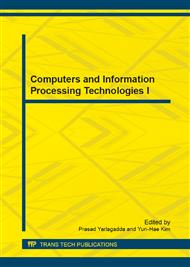[1]
Y. Saito, Y. Kenmochi, and K. Kotani. Estimation of eyeglassless facial images using principal component analysis. Proceedingsof the International Conference on Image Processing, 4: 172-201, (1999).
DOI: 10.1109/icip.1999.819578
Google Scholar
[2]
C. Du, and G. Su. Eyeglasses removal from facial images. Pattern Recognition Letters, 26: 2215-2220, (2005).
DOI: 10.1016/j.patrec.2005.04.002
Google Scholar
[3]
J. -S. Park, Y. H. Oh, S. C. Ahn, et al. Glasses removal from facial image using recursive error compensation. IEEE Transactions on Pattern Analysis and Machine Intelligence, 27(5): 805-811, (2005).
DOI: 10.1109/tpami.2005.103
Google Scholar
[4]
Z. Wang, and J. Tao. Face occlusion detection and reconstruction. Journal of Computer Research and Development, 47(1): 16-22, 2010. (In Chinese).
Google Scholar
[5]
G. Hu, and Z. Lou. Eyeglasses removal method based on occlusion region compensation. Application Research of Computers, 30(12): 3863-3865. (In Chinese).
Google Scholar
[6]
Y. Freund, and R. E. Schapire. Experiments with a new boosting algorithm. International Conference on Machine Learning, 96: 148-156, (1996).
Google Scholar
[7]
S. Liao, X. Zhu, Zhen Lei, et al. Learning multi-scale block local binary patterns for face recognition. International Conference on Biometrics, 828-837, (2007).
DOI: 10.1007/978-3-540-74549-5_87
Google Scholar
[8]
A. Telea. An image inpainting technique based on the fast marching method. Journal of Graphics Tools, 9(1): 23-34, (2004).
DOI: 10.1080/10867651.2004.10487596
Google Scholar
[9]
A. Criminisi, P. Perez, and K. Toyama. Object removal by exemplar-based inpainting. Proceedings of IEEE Computer Society Conference on Computer Vision and Pattern Recognition, 2: II-721, (2003).
DOI: 10.1109/cvpr.2003.1211538
Google Scholar
[10]
N. Otsu. A threshold selection method from gray-level histograms. Automatica, 11(285-296): 23-27, (1975).
Google Scholar
[11]
Y. Xiang, and G. Su. Multi-parts and multi-feature fusion in face verification. IEEE Computer Society Conference on Computer Vision and Pattern Recognition Workshops, 1-6, (2008).
DOI: 10.1109/cvprw.2008.4563107
Google Scholar
[12]
P. Viola, and M. Jones. Rapid object detection using a boosted cascade of simple features. Proceedings of the IEEE Computer Society Conference on Computer Vision and Pattern Recognition. 1: I-511-I-518. (2001).
DOI: 10.1109/cvpr.2001.990517
Google Scholar
[13]
T. F. Cootes, and C. J. Taylor. Statistical models of appearance for computer vision. Technical report, Imaging Science and Biomedical Engineering, University of Manchester, (2004).
Google Scholar
[14]
S. Milborrow, and F. Nicolls. Active shape models with SIFT descriptors and MARS. International Conference on Computer Vision Theory and Applications, 1(2): 5, (2014).
DOI: 10.5220/0004680003800387
Google Scholar


